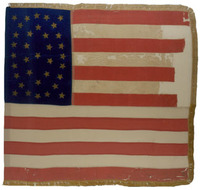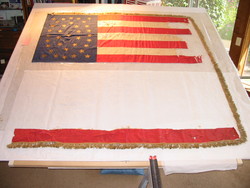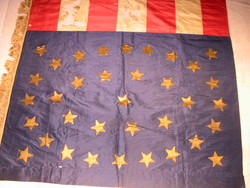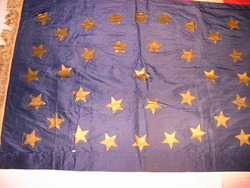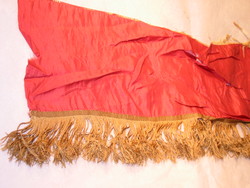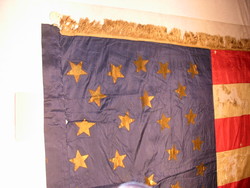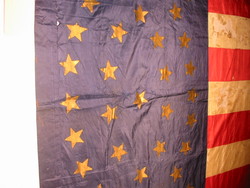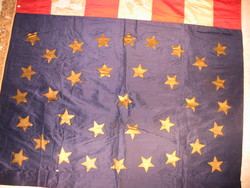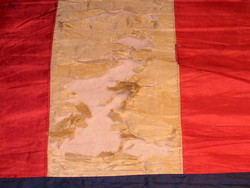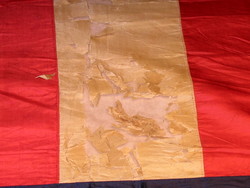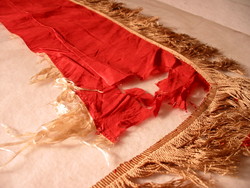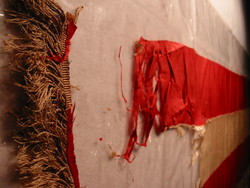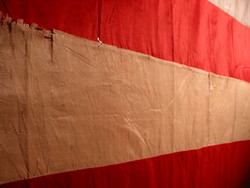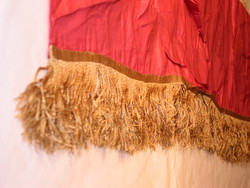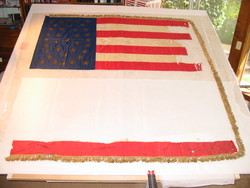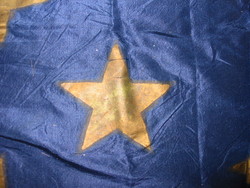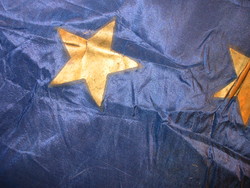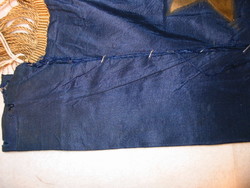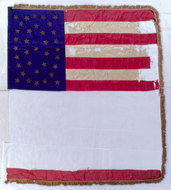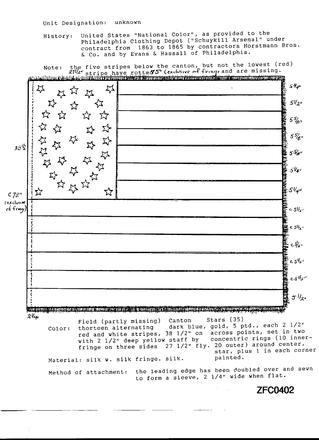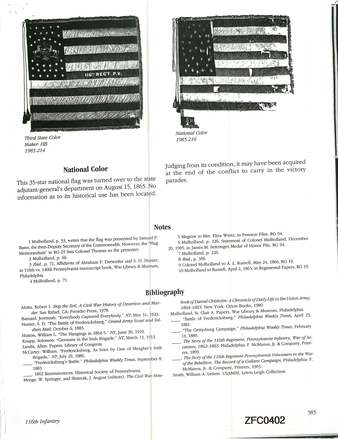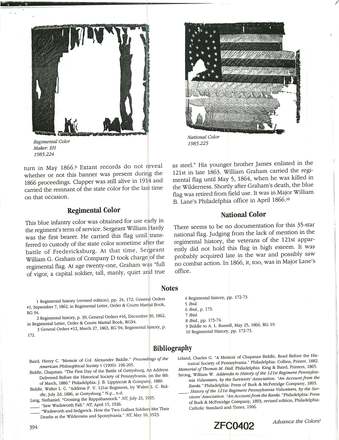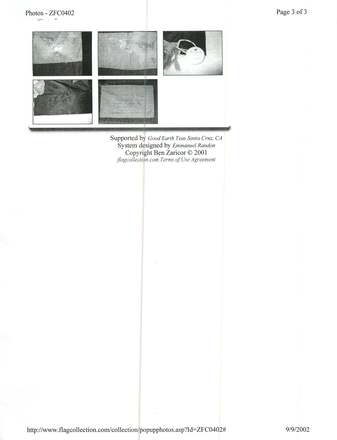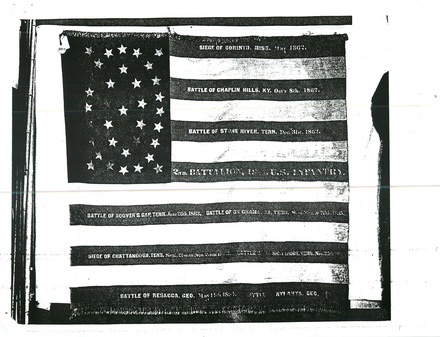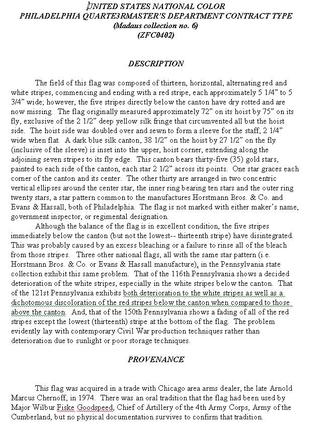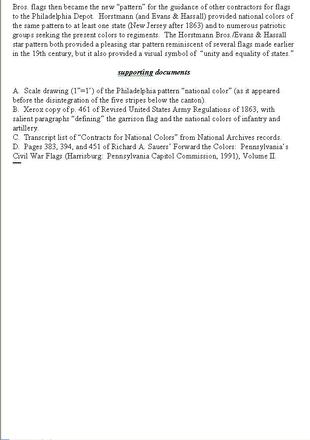U.S. 35 Star National Color, Double Ring Philadelphia Oval, 1863 - 1865.
At the start of the Civil War, the Federal Army was for the most part organized from volunteer regiments recruited by the Northern states. During the first year of the War the states provided all the equipment, including uniforms and flags, for these units. In early 1862, however, the federal government took over responsibility for equipping state volunteers. To meet the need for a color for each unit, the U.S. Quartermaster Department contracted for flags through each of its regional depots. Surprisingly, each depot had its own pattern to guide the contractors in the production of flags.
While the national colors provided to the New York and Cincinnati Q.M. depots had their stars arranged in horizontal rows, the pattern favored by the Philadelphia Depot arranged the stars in two concentric rings around a central star and filled out the canton with four corner stars. National colors and the accompanying blue regimental colors were issued to volunteer units unmarked with regimental designations. Unit commanders were responsible for properly inscribing the center stripes and the scrolls of the flags after receipt. This flag was never marked with its unit designation.
The oral tradition associated with this flag is that it was used during the American Civil war by Major Wilbur Fiske Goodspeed, Chief of Artillery for the 4th Army Corps of the US Army of the Cumberland. Major Goodspeed had formerly been Captain of Cotters Battery A, 1st Ohio Light Artillery. However, there is no documentation which supports this attribution.
The 4th Corps was organized October 9, 1863, and served with distinction at Missionary Ridge; Orchard Knob; Dandridge; Dalton; Rocky Face Ridge; Resaca; Cassville; Adairsville; New Hope Church; Pickett's Mills; Kenesaw Mountain; Smyrna Camp Ground; Vining's Station; Peach Tree Creek; Siege Of Atlanta; Jonesboro; Lovejoy's Station; Spring Hill; Franklin; Nashville and the Occupation Of Texas. They were disbanded before Christmas 1865.
This is outstanding example of a National Color as provided to the Philadelphia Clothing Depot (the Schuylkill Arsenal) under contract from 1863 to 1865 by contractors Horstmann Brothers & Co.; William F, Scheible and by former Horstmann employees Evans and Hassall, both of Philadelphia.
Although this flag bears no makers mark, inspectors stamp not unit designation, it is consistent with flags issued after 1862. Philadelphia made and issued national colors were distinguished by a star pattern of concentric ellipses, accented by a center sate and four corner stars. This arrangement seems to have been a conscious attempt to mimic the new small swallow-tailed flags issued to mounted troops as authorized in January of 1862.
Presumably, Major Goodspeed acquired this flag to use at his headquarters as Chief of Artillery of the 4th Corps, army of the Cumberland.
The Howard Michael Madaus sub-collection of Civil War Military Flags was assembled from a variety of sources over a thirty year period of collecting (1970-2000) before being acquired by the Zaricor Collection in 2000. The sub-collection attempts to present an example of each of the major types of depot contractor regulation flags and colors carried by Union forces at the basic unit level, i.e. regiment, battalion, company, and battery, as well as the types of general military flags.
This sub-collection (Howard Michael Madaus collection) added to the Zaricor Civil War collection is the largest and (while not complete) most comprehensive collection of the military flags carried by the Union Army during the Civil War outside of state repositories designated by the War Department for the disposition of these flags after the War or in public museum collections. In fact this private collection is larger and more comprehensive than many of the public museum collections in the United States.
Publication History:
Madaus, Howard M., Dr, Whitney Smith, The American Flag: Two Centuries of Concord and Conflict. Santa Cruz: VZ Publications, 2006, p. 70.
Schrambling, Regina, "A Lifelong Pledge." Collection, Published by Robb Report, June 2014, p. 48B.
Provenance:
• Made in Philadelphia, PA 1863-1865.
• Major Wilbur Fiske Goodspeed, Chief of Artillery for the 4th Army Corps of the US Army of the Cumberland, 1863-1865.
• Acquired by Marcus Chernoff, until 1974.
• Purchased by Howard Michael Madaus, Cody, WY, 1974.
• Madaus Flag Collection, Madaus #6, until 2000.
• Acquired by Zaricor Flag Collection by Private Sale from the Madaus Flag Collection, 2000
ZFC Significant Flag
Item is Framed
Sources:
Madaus, Howard M.- Whitney Smith, The American Flag: Two Centuries of Concord and Conflict, VZ Publications, Santa Cruz, 2006.
US Army Quartermaster General, Flags of the Army of the United States carried during the War of the Rebellion, 1861-1865, to designate the headquarters of the different armies, army corps, divisions and brigades, Washington, D.C., 1887.
Todd, Frederick P., American Military Equipage 1851-1872, Volume 2, Providence, The Company of Military Historians, 1977.
Katcher, Phillip, Flags of the American Civil War, 2: Union, London, Osprey, 1993.
Madaus, Howard M., correspondence to Ben Zaricor, 29 March 2000, Zaricor Flag Collection Archives.
Image Credits:
Zaricor Flag Collection
CSG
USAC
USANC
xyz
